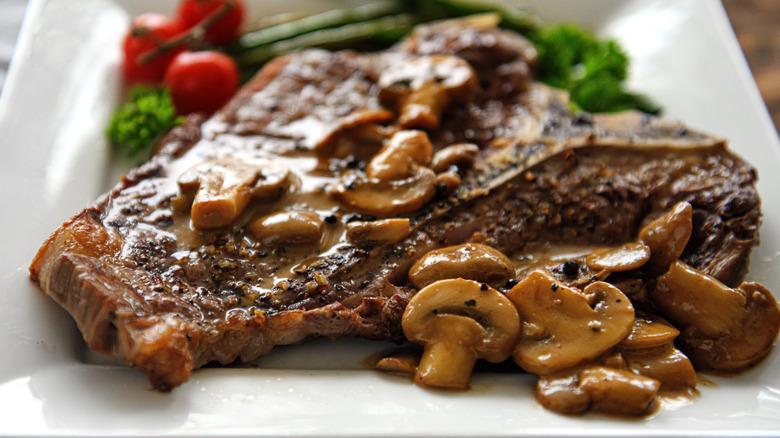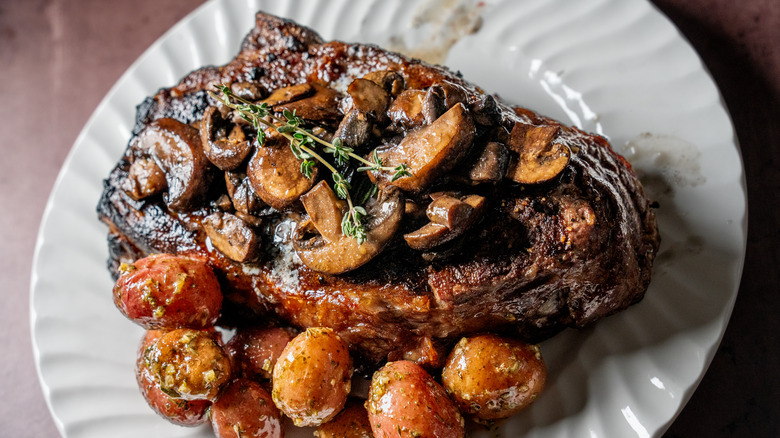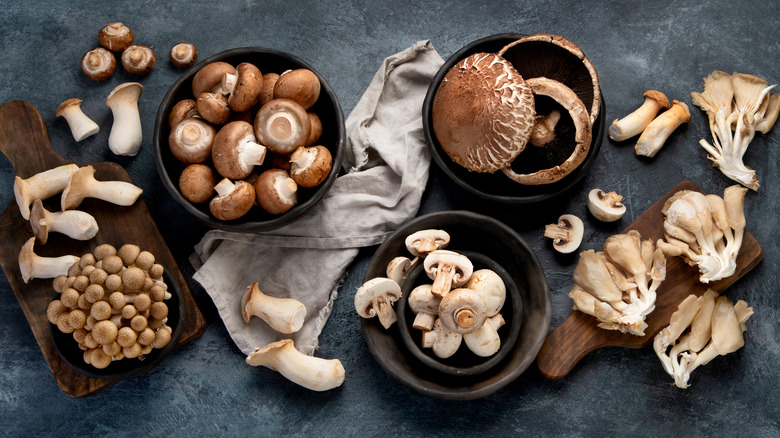Amp Up Your Steak With A Rich Burgundy Mushroom Sauce
Sometime between the period of 410 and 1066 A.D., the term "stelk" was invented to describe meat on a stick. Over time, this Anglo-Saxon word has evolved to what is now recognized as "steak." Some cuts of steak, with their moist, thick, and juicy dispositions, need only a sprinkling of salt to bring out their natural flavors; other cuts, however, might need a sauce to enhance the taste. Instead of going for a store-bought bottle of premade sauce or attempting to make a chocolate-based steak sauce, why not deepen the flavors of your steak with a Burgundy mushroom sauce?
The blend of smooth butter, bittersweet red wine, tangy shallots, soft mushrooms, fresh herbs, and a deep demi-glace makes a Burgundy mushroom sauce a triumphant match to steak. It's delectably rich and creamy while also teaming with complex notes of umami. Just picture the thick consistency of the Burgundy sauce beautifully cascading over a seared steak.
A Burgundy sauce complements the steak's naturally fatty and distinct savoriness, imparting deep, tantalizing notes that will harmonize with each bite. The next step to unlocking this sauce is understanding the key ingredients: wine, demi-glace, mushrooms, and bouquet garni.
The remarkable three
For the ultimate Burgundy sauce, there are three ingredients you must masterfully select or prepare: demi-glace, wine, and bouquet garni. Demi-glace is a thick brown sauce made from beef stock, brown sugar, black peppercorns, brown sauce, and various herbs. It's ridiculously deep in flavor and acts as the foundation for a Burgundy sauce. It is vital that your demi-glace sauce is carefully prepared, or a reputable brand of pre-made is purchased, as this will make or break your Burgundy sauce and steak.
Next is the choice of wine. Naturally, a Burgundy cooking wine would be the ideal option here as its full-bodied, rich taste provides another complex level of flavor in the sauce. If you can't find an affordable Burgundy wine for cooking, a merlot, cabernet Sauvignon, or Rioja would make a worthy substitute.
Finally, the herbs in a Burgundy sauce act as a culinary bridge, infusing the rich flavors of the wine, demi-glace, and mushrooms with subtle nuances of earthy aromatics. In Burgundy sauce, it can be added as a bouquet garni or herbal bundle that can easily be discarded once the sauce is ready to serve. A bouquet garni usually includes parsley, bay leaves, and thyme sprigs, all of which will complement the flavors in a Burgundy sauce.
A moment for the mushrooms
So far, a staggering 14,000 mushroom species have been recorded, and while the vast array may not make it to your kitchen, it's essential to recognize different types of mushrooms and how to use them, especially when it comes to making a Burgundy mushroom sauce. White mushrooms are the most mild in flavor, and will effortlessly meld into your Burgundy sauce. These are ideal if you want the sliced mushroom texture without an intense mushroom taste. Similarly, cremini mushrooms will also work well if you're a fan of a mild mushroom flavor. They also have a more meaty texture, which will complement steak well. For a richer taste, portobello mushrooms would work. Just be aware that they are more dense, so they will add a heavier texture to the sauce. To achieve an optimum texture in the sauce, it's best to incorporate thickly sliced mushrooms, as these will shrink once they're cooked, and you want the Burgundy sauce to have body and texture.
The next time it's steak night, consider celebrating the flavors of this globally popular cut of beef with a rich burgundy mushroom sauce. You will not be disappointed.


